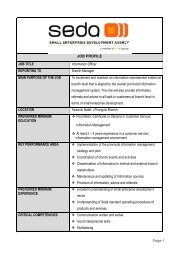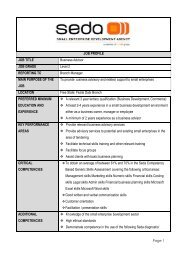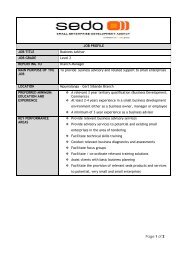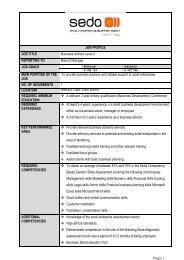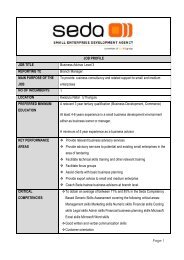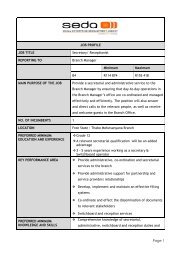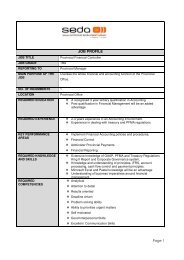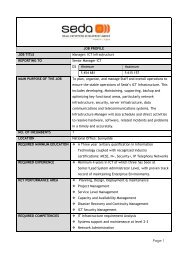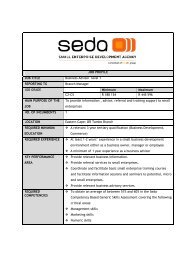Assessment of Cooperatives in the Poultry Industry - 2013.pdf - Seda
Assessment of Cooperatives in the Poultry Industry - 2013.pdf - Seda
Assessment of Cooperatives in the Poultry Industry - 2013.pdf - Seda
Create successful ePaper yourself
Turn your PDF publications into a flip-book with our unique Google optimized e-Paper software.
Research Report: Address<strong>in</strong>g <strong>the</strong> Needs, Opportunities and Challenges <strong>of</strong> <strong>Cooperatives</strong><br />
and Collectively Owned Enterprises <strong>in</strong> <strong>the</strong> <strong>Poultry</strong> and Related Industries<br />
segments: survivalists, micro and small to medium cooperatives. The vision <strong>of</strong> <strong>the</strong> strategy is to be<br />
consistent with that <strong>of</strong> <strong>the</strong> Cooperative Development Policy (2004) which states:<br />
“To move towards a grow<strong>in</strong>g, self-susta<strong>in</strong>able and <strong>in</strong>tegrated cooperative sector, supported<br />
by all stakeholders, contribut<strong>in</strong>g to economic growth, poverty reduction and employment<br />
creation, as well as assist<strong>in</strong>g <strong>in</strong> br<strong>in</strong>g<strong>in</strong>g about economic transformation and an equitable<br />
society <strong>in</strong> South Africa.” (Department <strong>of</strong> Trade and <strong>Industry</strong> [<strong>the</strong> dti], 2010:10)<br />
The follow<strong>in</strong>g objectives have been identified <strong>in</strong> <strong>the</strong> strategy, which are aligned with <strong>the</strong> Cooperative<br />
Development Policy (2004):<br />
<br />
<br />
<br />
<br />
<br />
<br />
<br />
<br />
<br />
<br />
grow all forms and types <strong>of</strong> cooperatives<br />
promote cooperatives as a vehicle to assist <strong>in</strong> creat<strong>in</strong>g decent employment and reduc<strong>in</strong>g<br />
poverty through <strong>in</strong>come-generat<strong>in</strong>g activities<br />
support cooperatives <strong>in</strong> develop<strong>in</strong>g <strong>the</strong>ir human resource capacities and understand<strong>in</strong>g <strong>of</strong><br />
cooperative pr<strong>in</strong>ciples and values<br />
streng<strong>the</strong>n cooperative susta<strong>in</strong>ability<br />
<strong>in</strong>crease sav<strong>in</strong>gs and <strong>in</strong>vestment<br />
foster co-operation among cooperatives<br />
raise <strong>the</strong> pr<strong>of</strong>ile <strong>of</strong> cooperatives as a dynamic and effective bus<strong>in</strong>ess organisation that can be<br />
utilised by <strong>in</strong>dividuals and communities<br />
raise <strong>the</strong> pr<strong>of</strong>ile <strong>of</strong> cooperatives as an <strong>in</strong>stitution that allows <strong>the</strong> agglomeration <strong>of</strong> smallscale<br />
economic activities <strong>in</strong>to massive activities<br />
aggressively promote closed cooperatives<br />
promote cooperatives as an effective vehicle that contributes to <strong>the</strong> development <strong>of</strong> rural<br />
and peri-urban areas <strong>of</strong> <strong>the</strong> economy<br />
In addition, <strong>the</strong> strategy also identified four strategic pillars that address <strong>the</strong> support <strong>in</strong>struments for<br />
cooperatives. Each strategic pillar consists <strong>of</strong> support programmes designed to respond to <strong>the</strong><br />
various market segments and to address <strong>the</strong> challenges that cooperatives are faced with. The four<br />
strategic pillars are as follows:<br />
<br />
<br />
<br />
<br />
to <strong>in</strong>crease <strong>the</strong> supply <strong>of</strong> non-f<strong>in</strong>ancial support services to cooperatives<br />
to create demand for cooperative products and services<br />
to improve <strong>the</strong> susta<strong>in</strong>ability <strong>of</strong> cooperatives<br />
to <strong>in</strong>crease f<strong>in</strong>ancial support services to cooperatives<br />
Implications for SEDA and <strong>Poultry</strong> <strong>Cooperatives</strong>: although this strategy is primarily focused on <strong>the</strong><br />
development and promotion <strong>of</strong> cooperatives, attention is given to o<strong>the</strong>r aspects such as f<strong>in</strong>anc<strong>in</strong>g,<br />
creat<strong>in</strong>g demand, and <strong>the</strong> improvement <strong>of</strong> susta<strong>in</strong>ability. New and exist<strong>in</strong>g cooperatives <strong>of</strong> all sizes are<br />
<strong>in</strong>cluded as part <strong>of</strong> this strategy and special attention will be given to <strong>the</strong> susta<strong>in</strong>ability <strong>of</strong> cooperatives.<br />
31 | P a g e U r b a n - E c o n : D e v e l o p m e n t E c o n o m i s t s



